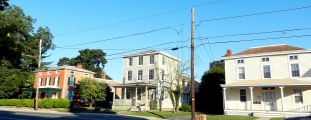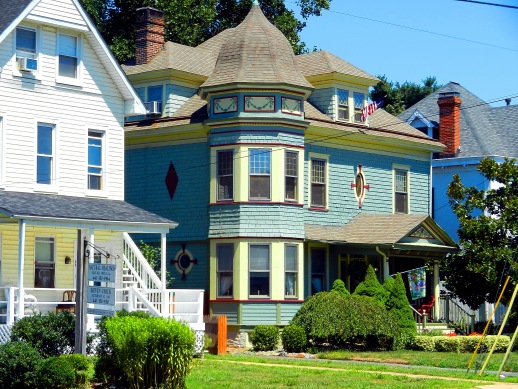 Last week the Mayor and Commissioners of Elkton heard that the burden associated with the town’s historic district outweigh its benefits. Members of the appointed group overseeing the special zoning area, the Historic and Architectural Review (HARC) Committee, aired those concerns, saying the “restrictive requirements” are “like Monticello” and put HARC in charge of “maintaining to the very minutiae” in a town that doesn’t have a “historic corridor.” Usually these types of boards are known for their zeal in preserving the past, so for another perspective Someone Noticed asked a Maryland Historical Trust Planner, Cory R. Kegerise, about matters raised at the meeting.
Last week the Mayor and Commissioners of Elkton heard that the burden associated with the town’s historic district outweigh its benefits. Members of the appointed group overseeing the special zoning area, the Historic and Architectural Review (HARC) Committee, aired those concerns, saying the “restrictive requirements” are “like Monticello” and put HARC in charge of “maintaining to the very minutiae” in a town that doesn’t have a “historic corridor.” Usually these types of boards are known for their zeal in preserving the past, so for another perspective Someone Noticed asked a Maryland Historical Trust Planner, Cory R. Kegerise, about matters raised at the meeting.
With over 400 years of history, it would seem that the county seat’s built environment has a sufficient inventory that deserves protection, as the 2010 Elkton Comprehensive Plan notes. Beyond that the Maryland Historical Trust found in the early 1980s that Elkton was an architecturally significant town that possessed a large number of well-preserved structures, “with an especially fine concentration of houses, churches and commercial buildings dating from the latter half of the 19th century.”
Neighborhoods are still full of centuries old charm
So has the loss of valuable structures from another era accelerated to the point the neighborhood atmosphere has been lost since the thirty-year old study found five distinct concentrations of buildings eligible for listing in the National Register? While loss driven by was described as “Swiss Cheese” affect has reduced the inventory, several sections of the town retain distinctiveness worthy of stabilization and preservation. For example, the survey concluded that the E. Main Street neighborhood retained a high degree of integrity with few modern intrusions. A drive down that attractive street today, shows that it is still full of centuries old-character and charm and is worthy of protection, especially in a municipality that struggles with policies related to halting the deterioration of its neighborhoods.
When asked if the Secretary of the Interior’s regulations are too detailed and contain restrictive regulations requiring HARC to deal with minutia, here is how Cory answered that. The Secretary of Interior Standards consist of 10 statements describing “how changes and alterations to historic building should be approached.” “They are not strict, prescriptive rules that dictate every minute detail.” To support the standards the Park Service developed 60 pages of guidelines. “Guidelines are guidelines and not regulations . . . . The entire process is based upon the application of general guidelines to individual circumstances, within which there is often significant variation.”
HARC talked about whether Elkton should develop design guidelines, which become even stricter, according to some on the board. Generally community-specific design guidelines are developed to aid the review process and help owners know how to approach work on a structure. The guidelines don’t tell an owner or developer which features of their own historic building are important in defining the historic character and should be preserved or which features can be alerted. “That’s where local design guidelines come in. Design guidelines developed for a local historic district can get into finer levels of detail . . . and give treatment recommendations and explanations that apply to actual buildings and building types. District specific design guidelines give commissioners the opportunity to be much more explicit and clear about materials, spaces and features. “I challenge anyone to actually read the standards and guidelines and find a passage that requires the building to be returned to a particular point in time. All that being said, guidelines need to be applied evenly and consistently once they are adopted,” the state preservation official advised.
The regulations recognize that there will be what the professional preservationist called “non-conforming” structures in a district. Within any district there are buildings that are clearly related to the significance of the neighborhood while there are also buildings that bear no relation to the significance of the district and they are considered to be “non-contributing.” The standards say that a non-contributing building should not be held to a high standard in the way a contributing building is.
Towns and counties are under no obligation to enact historic area zoning ordinances or require any kind of design review beyond what is required or life safety, health, environmental or other land use concerns. But “many communities have determined that preserving historic buildings and streetscapes from demolition, deterioration and alterations that radically alter the historic charter and environment is important to them. It gives those communities a sense of place, a unique identity a distinction and an economic advantage over other place,” Cory concluded.

